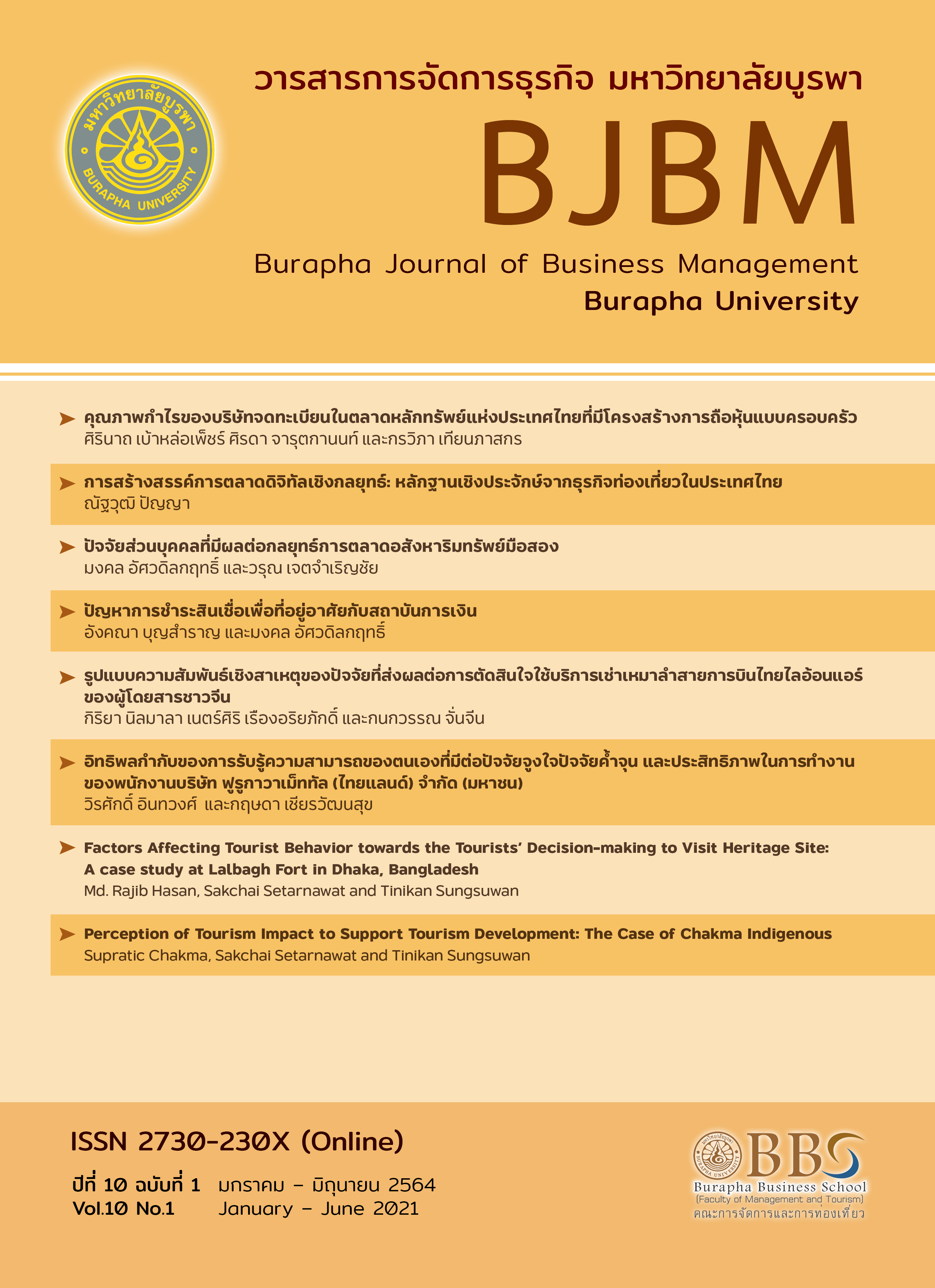Factors Affecting Tourist Behavior towards the Tourists’ Decision-making to Visit Heritage Site: A case study at Lalbagh Fort in Dhaka, Bangladesh
Main Article Content
บทคัดย่อ
The primary aim was to study the partial utility of Theory of Planned Behavior (TPB) as a conceptual framework for predicting tourists’ behavior and making decision to visit a heritage site. This study used Lalbagh Fort in Dhaka, Bangladesh as a study site. The objectives of the study were to 1) examine the factors affecting tourists’ behavior and to 2) investigate the relationships between behavior and the decision-making of tourists to visit a heritage site.
The primary data collected through a questionnaire from 400 respondents with probability sampling method of local tourists who were visiting Lalbagh Fort. Data was analyzed by hypothesis testing using SEM analysis including CFA of tourist behavior and decision-making behavior.
The observed result of this study showed some different views from the actual TPB model. Two hypotheses: Influence of reference groups, and Behavioral intention to visit had a positive effect on decision-making behavior to visit a heritage site. The other two hypotheses: Attitude toward visit, and Perceived behavioral control had a positive effect on behavioral intention to visit a heritage site, but found to be different for the Bangladeshi local tourists as they were statistically not significant.
For future research, this result could be applied to other heritage sites using different models and methods. Also, comparing to the results with the same topic but from other countries could be a better step for the heritage tourism of Bangladesh.
Article Details
บทความที่จะตีพิมพ์เพื่อเผยแพร่ในวารสารการจัดการธุรกิจ มหาวิทยาลัยบูรพา จะต้องเป็นบทความที่ไม่เคยได้รับการตีพิมพ์เผยแพร่หรืออยู่ระหว่างการพิจารณาเพื่อตีพิมพ์เผยแพร่ในวารสารอื่น ๆ ทั้งนี้ หากพบว่ามีการละเมิดลิขสิทธิ์ ด้วยข้อคิดเห็นที่ปรากฏและแสดงในเนื้อหาบทความต่าง ๆ ให้ถือว่าเป็นความเห็นและความรับผิดชอบโดยตรงของผู้เขียนบทความนั้น ๆ มิใช่ความเห็นและความรับผิดชอบใด ๆ ของคณะบริหารธุรกิจ มหาวิทยาลัยบูรพา สำหรับในกรณีผู้ประสงค์จะนำข้อความในวารสารการจัดการธุรกิจ มหาวิทยาลัยบูรพา ไปเผยแพร่ต้องได้รับอนุญาตจากกองบรรณาธิการวารสารการจัดการธุรกิจ มหาวิทยาลัยบูรพา ตามกฎหมายว่าด้วยลิขสิทธิ์
เอกสารอ้างอิง
Ajzen, I. (1985). Action control. Heidelberg: Springer.
Ajzen, I. (1989). Attitude structure and behavior. Attitude structure and function, 3, 241-274.
Ajzen, I. (1991). The theory of planned behavior. Organizational behavior and human decision processes monthly, 50(2), 179-211.
Ajzen, I. (2002). Perceived behavioral control, self‐efficacy, locus of control, and the theory of planned behavior. Journal of Applied Social Psychology, 32(4), 665-683.
Anderson, J. C., & Gerbing, D. W. (1988). Structural equation modeling in practice: A review and recommended two-step approach. Psychological Bulletin, 103(3), 411-423.
Buttle, F., & Bok, B. (1996). Hotel marketing strategy and the theory of reasoned action. International Journal of Contemporary Hospitality Management, 8(3), 5-10.
Chen, J. S. (1997). Factors influencing tourists' choices of heritage destinations. Doctoral dissertation, Department of Recreation, Park, and Tourism Management, The Pennsylvania State University.
Conner, M., Kirk, S. F., Cade, J. E., & Barrett, J. H. (2001). Why do women use dietary supplements? The use of the theory of planned behaviour to explore beliefs about their use. Social Science & Medicine, 52(4), 621-633.
Correia, A., Kozak, M., & Ferradeira, J. (2011). Impact of culture on tourist decision‐making styles. International Journal of Tourism Research, 13(5), 433-446.
Cronin, P., Ryan, F., & Coughlan, M. (2008). Undertaking a literature review: A step-by-step approach. British journal of nursing, 17(1),38-43.
Eagly, A. H., & Chaiken, S. (1993). The psychology of attitudes. New York: Harcourt Brace Jovanovich College Publishers.
Goh, E. (2010). Understanding the heritage tourist market segment. International Journal of Leisure and Tourism Marketing, 1(3), 257-270.
Hair, J. F., Black, W. C., Babin, B. J., & Anderson, R. E. (2013). Multivariate data analysis: Pearson new international edition. Alabama: Pearson Higher Education.
Howard, D. R., & Crompton, J. L. (1984). Who are the consumers of public park and recreation services? An analysis of the users and non-users of three municipal leisure service organizations. Journal of Park and Recreation Administration, 2(3), 33-48.
Hsu, C. H., & Huang, S. (2012). An extension of the theory of planned behavior model for tourists. Journal of Hospitality & Tourism Research, 36(3), 390-417.
Hu, B., & Bentler, R. (1999). Cutoff criteria for fit indexes in covariance structure analysis: Coventional criteria versus new alternatives. Structural Equation Modeling, 6(1),1-55.
Lam, T., & Hsu, C. H. (2006). Predicting behavioral intention of choosing a travel destination. Tourism Management, 27(4), 589-599.
Lee, J., Moon, S., Cha, Y., & Chung, D.Y. (2010). Drosophila TRPN (= NOMPC) Channel Localizes to the Distal End of Mechanosensory Cilia. Plos one, 5(6), 1-6.
Smallman, C., & Moore, K. (2010). Process studies of tourists’ decision-making. Annals of Tourism Research, 37(2), 397-422.
Stangor, C. (2004). Social groups in action and interaction. London: Routledge.
Taylor, S., & Todd, P. (1995). Decomposition and crossover effects in the theory of planned behavior: A study of consumer adoption intentions. International Journal of Research in Marketing, 12(2), 137-155.
Yamane, T. (1967). Problems to accompany statistics: An introduction analysis. New York: Harper & Row.


